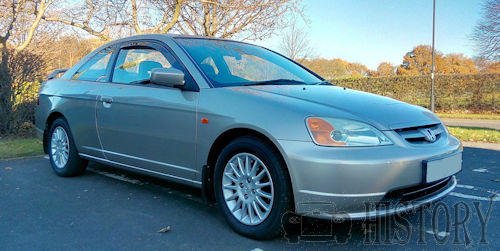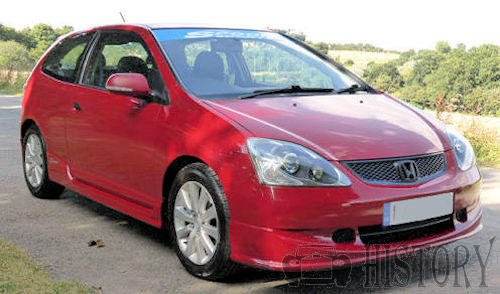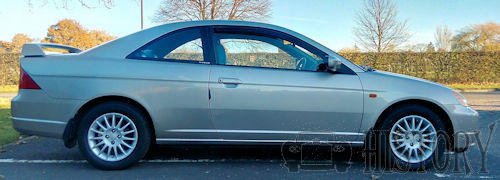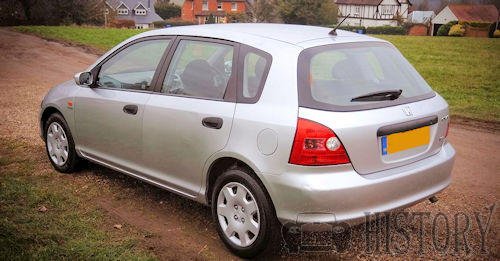Honda Civic Seventh generation (2000–2005)
 |
|
| Manufacturer | Honda |
|---|---|
| Production | 2000–2005 |
| Model years | 2001–2005 |
| Assembly | Swindon, England Suzuka, Japan East Liberty, Ohio Alliston, Ontario, Canada Hsinchu, Taiwan (End 2002) Ayutthaya, Thailand Sumaré, Brasil Santa Rosa City, Laguna, Philippines |
| Predecessor | Honda Civic (sixth generation) |
| Successor | Honda Civic (eighth generation) |
| Class | Compact car |
| Body style | 2-door coupe (EM) 3-door hatchback (EP) 4-door sedan (ES) 5-door hatchback (EU) |
| Layout | Front-engine, front-wheel drive |
| Engine | 1.5 L D15B I4 1.5 L D15Y2 I4 1.5 L D15Z6 I4 1.6 L D16W7 I4 1.7 L D17A1 I4 1.7 L D17A6 I4 1.7 L D17A2 I4 2.0 L K20A3 I4 |
| Transmission | 5/6-speed manual 4-speed automatic |
| Wheelbase | 103.1 in (2,619 mm) (sedan/coupe) 101.6 in (2,581 mm) (3-door hatchback) |
| Length | 174.7 in (4,437 mm) (2001-03 coupe) 174.6 in (4,435 mm) (2001-03 sedan) 168.4 in (4,277 mm) (3-door hatchback) 175.4 in (4,455 mm) (2004-05 sedan/coupe) |
| Width | 67.7 in (1,720 mm) |
| Height | 55.1 in (coupé) 56.7 in (1,440 mm) (sedan) 58.7 in (1,491 mm) (3-door hatchback) |
| Curb weight | 2,744 lb (1,245 kg) (hatchback) 2,405 lb (1,091 kg) (coupé) 2,421 lb (1,098 kg) (sedan) |
| Related | Honda Integra DC5 Acura EL Honda CR-V Honda Stream |
| Designer(s) | Shuji Koman (1998) |
A 115 hp (86 kW) engine powered all Civics (except EX and Si), up 9 hp (7 kW) from the previous model. Power in the EX remained at 127 hp (95 kW), and all non-Si engines were stroked to 1.7 liters for North America. Smaller engines continued to be available for the rest of the world.
History
In 2003, the Civic was given new tail lights which created a circle when illuminated. For 2004, the Civic was given a facelifted front end with new headlights, bumper, and grille; it also received side skirts. In 2005 the U.S Honda introduced the Special Edition. It was available in LX or EX Special Edition.

The hybrid version arrived at North America in spring 2002. It used both a small 1.3 L I4 main gasoline engine and auxiliary electric motors, producing a combined 93 hp. The electric motors are powered by a battery array which is charged by regenerative braking during deceleration, thus reducing exhaust emissions and extending fuel mileage to 46 mpg city / 51 mpg highway with the manual transmission according to EPA fuel mileage estimates.
A sporting hatchback model called the Si was unveiled in August 2005 for the European market only. This model featured from launch a 1.4 L I-DSI and a 1.8 L i-VTEC rated at 83 PS (81 hp/61 kW) and 140 PS (138 hp/103 kW) respectively, with 177 and 207 km/h (110 and 129 mph) top speeds and 14.2 and 13.6 s 0–100 km/h sprint. The Sport Hatchback is also available with a 2.2 L I-CTDI diesel engine from the Accord, Edix/FR-V and CR-V, rated at 140 PS (138 hp/103 kW) and is capable of 205 km/h (127 mph) and accelerating from 0-60 mph in 8.4 seconds.
Starting with this generation, cabin air filters (also known as pollen filters) were installed as standard equipment and are located behind the glove compartment internationally.
Trim levels

Coupé: Trims available in North America for the coupé body style were the VP, DX (up to 2003), EX, HX, LX (EM2), LX Special Edition or EX Special Edition, and Si. The Coupé was no longer available in Japan, but was still marketed in Europe.
Sedan: Trims available in the sedan body style were the DX, EX, GX, LX, LX Special Edition, EX Special Edition, Hybrid (ES1/2, EN2, ES1, respectively), and Si. EX trim includes sunroof. The LX or EX Special Edition included a six-disc changer and rear spoiler, ABS, larger 15-inch wheels, and a more powerful engine (see below). There was also the EX Special Edition which added a sunroof and rear single cup holder. The Hybrid was the only trim available for the sedan style in Europe.
Different models were available for the Canadian market:
Up until 2003 there were DX and LX models for both sedan and coupé, with the coupé additionally having the Si trim, largely equivalent to the US market EX coupé.
In 2002, Honda Canada, in recognition of the one millionth sale of the Civic in Canada, introduced a limited edition version of the Civic called the Civic Coupe Si Veloz ('Veloz' meaning 'swift' in Spanish). The Veloz edition adds a front, rear, and side skirts, rear spoiler, carbon fiber trim pieces, chrome exhaust finisher, custom Veloz embroidered floor mats and Veloz badges.
In 2003, a 30th Anniversary Edition was added to all models, as well as a Sport model for sedans. In 2004, the DX model was replaced by a Special Edition (SE) model and the previous Sport model was replaced by a LX-g trim.
Si
The EP3 Civic Si was badged SiR in Canada. Unlike other generations of the Civic Si, this Si was not produced in Canada or the United States, and it does not share a body style or interior with the USDM Civic (offered only in sedan and coupé forms) sold there. Instead, the 2002-05 Civic Si is manufactured in Swindon, England, and exported to Canada and the United States. The Si was the only trim available for the hatchback style in Canada and the United States. 2,740 lb (1,240 kg)
The Civic Si returned to form as a hatchback, after having been sold only as a coupé in the previous generation. The body shape of this model was based on the "New Bullet-Form" concept, which aimed to create a more dynamic look and provide greater stability while traveling on highways or winding country roads. The interior layout also distinguished itself from other Civic Si generations with a dash-mounted shifter. The EP hatchback is also used for the second generation Civic Type R which was sold in Europe and Japan.
Shifting away from the B-series engine, the seventh generation Civic Si adopted the K-series K20A3 engine used in the Acura RSX base model rated at 160 bhp (120 kW) at 6500 rpm and 132 lbf·ft (179 N·m) at 5000 rpm. With a redline of 6,800 rpm, the Si distanced itself from the narrow, high-rpm powerband engine of its predecessor, and as a result saw a 20 percent increase in torque. Performance was relatively underwhelming compared to the competition; the switch to MacPherson struts from double-wishbone suspension resulted in less responsive handling, and a near-150 lb (68 kg) increase in weight to 2,744 lb (1,245 kg) contributed to slower acceleration than the lighter '99-'00 Si Much of the weight gain is attributed to the chassis' stouter structure when compared to the previous generation hatchback, with the '02 Si boasting an increase in torsional rigidity by 95 percent and a bending rigidity increase of 22 percent.
With the increased chassis rigidity compensating for weight gain, the 5th-generation Civic Si saw roughly the same performance numbers as the previous generation Si, with 7.6 seconds to 60 mph and 15.9 seconds at the quarter mile, which were comparable to that of Ford SVT Focus and Hyundai Tiburon GT V6.Other factors adversely impacting performance included the lack of an LSD (limited slip differential) and having to shift into third gear to get to 60. First gear ends at about 30, second ends at 55, and third ends at 82 mph (132 km/h).
The 2004–05 models received minor revisions. Cosmetic changes included revised headlight (dual bulb setup) and taillight designs, standard side skirts, and an option for a HFP. The suspension was updated with a change from 4 lug to 5 lug bolt pattern, a larger rear sway bar, and a change from 15-inch wheels (195/60-15) to 16-inch wheels (205/55-16). The interior received more silver accents in place of the chrome ones (the lock switch).
2003 Honda Civic Si Concept (2002)
For the 2002 SEMA show, Honda unveiled the 2003 Civic Si Concept, which showcased the aftermarket versatility of the Si.
Powertrain/chassis modifications included a GReddy T518Z turbocharger with an integral wastegate, a prototype GReddy front-mounted intercooler kit with aluminum piping, a GReddy Airinx high-flow intake system, a GReddy e-manage engine control manager, a GReddy Profec E-01 electronic boost controller (with e-manage programmer), widened track, Factory Performance sport suspension, a center mounted high-flow exhaust system, and a four-piston Brembo brake system.
The exterior saw changes including a Rally-inspired body kit, 18-inch polished titanium skin torpedo, a carbon fiber grill, front intake and rear bumper diffuser, a black chrome-finish headlights and smoked taillights, high-mounted two-stage rear wing. For the interior, Honda included Mugen carbon fiber and Kevlar race seats covered in red Alcantara suede with 6-point racing harness, a sport 3-spoke steering wheel, aluminum pedals and shift knob, Mugen high performance LCD screen gauge package, center mounted information display.
Engines
Most DX and LX models had the D17A1. The HX had the D17A6 and the EX had the D17A2. The Si(EP3) had the K20A3. The JDM 5-door hatchback (EU) had the D15B. The GX runs on CNG. The Philippine and Middle East version of the 7th generation Honda Civic used the 3-stage VTEC mechanism for their VTi/VTi-S/RS Civics, equipped with a D16W9 rated with 130 hp (97 kW). So, Japan RS model is D17A. Factbook.
In Europe the Civic was sold also with a common-rail diesel engine produced by Isuzu Motors Polska. This engine is a 1.7L 4EE2 Circle L engine with 100 hp (75 kW).
The seventh generation North American Civic DX/LX/Value Package engines were the last in the Honda and Acura not to use Honda's variable valve time system aka (VTEC) along with the 1996-2004 Acura 3.5RL Non-Vtec engines.

Technical
-
Honda Civic 7th gen Technical details (2000-2005)
Honda Civic 1.7D CTDi Engine: 4EE2
No. of cylinders 4/DOHC
Capacity 1686 cc
Compression ratio 18.4:1
Fuel/injection Make Bosch Common rail
Oil pressure 1.3 bar
Thermostat opens 83 and 87°CHonda Civic 1.6 petrol Engine:D16W
No. of cylinders 4/OHC
Capacity 1590cc
Firing order 1-3-4-2
Compression ratio 10.4:1
Suitable for unleaded petrol Yes
Diagnostic socket Yes
Fuel system Regulated pressure 2.7-3.2bar
Injector 10-13 Ohm
Oil pressure 3.5 bar @ 3000 rpm
Thermostat opens 76-80°C
Opions: Equipment included on some trim levels - 3x3 point rear seat belts
- Air conditioning
- Alarm
- Alloy wheels
- Audio remote
- CD
- Central locking
- Climate control
- Cloth seat trim
- Cruise control
- DVD
- Electric mirrors
- Electric sunroof
- Folding rear seats
- Front fog lights
- Full size spare wheel
- Heated mirrors
- Heated seats
- Height adjustable drivers seat
- Isofix child seat anchor points
- Leather seat trim
- Metallic Paint
- Partial leather seat trim
- Rear electric windows
- Remote locking
- Sat Nav
- Side airbags
- Space saver spare wheel
- Sports seats
- Steel wheels
- Traction control
© Motor car History
Service
-
Honda Civic 7th gen maintenance and Service Guide (2000-2005)
Automatic transmission fluid Type ATF-Z1
Automatic transmission fluid change 2.7 litres
Manual gearbox oil 4/5 speed 2.0 litres
Cooling system 5.3 litres
Brake fluid Type DOT 4
Parking brake travel No.of notches 7-8Power steering fluid Type Honda PAS or Electric
Power steering fluid 1.0 litres1.7D CTDi Engine: 4EE2
Valve clearance - INLET 0.40±0.05mm check cold
Valve clearance - EXHAUST 0.40±0.05mm check cold
Engine oil grade - normal/moderate climate 5W/40 SAE Synthetic
Engine oil change 5.8 litres1.6 petrol Engine:D16W
Spark plugs Original equipment NGK Type ZFR5J-11
Spark plugs Electrode gap 1.0-1.1mm
Spark plugs Tighten 18 Nm
Valve clearance -INLET 0.18-0.22mm check cold
Valve clearance -EXHAUST 0.23-0.27mm check cold
Engine oil grade - normal/moderate climate 10W/30 or 10W/40SAE
Engine oil grade - hot climate 10W/40SAE
Engine oil grade - cold climate 5W/30 SAE
Engine oil change 3.2litres
Cooling system 4.0 litres© Motor car History
